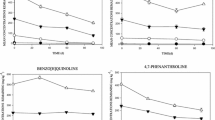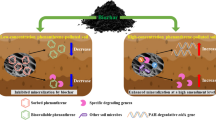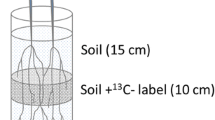Abstract
Nitrogen- heterocyclic polycyclic aromatic hydrocarbons (N-PAHs) are ubiquitous constituents of contaminated sites in which their high water solubility and lower k ow values imply greater mobility and impacts. Biodegradation is a major route of loss for organic contaminants in soil. In this study, microbial degradation was investigated in soil artificially contaminated with N-PAHs and monitored for over 200 days. The results showed that all the aromatic chemicals exhibited loss with increasing incubation time; however, only 0.05 ± 0.04 mg kg day−1 loss was observed for N-PAHs at 10 mg kg−1 amendments over the first 30 days incubation, with the exception of 4,7-phenanthroline which recorded 0.19 ± 0.03 mg kg day−1. The study showed that soil microflora have the potential to degrade N-PAHs since all of the aromatics recorded chemical losses under aerobic condition. However, degradation rates varied between chemicals and this was attributed to N-atom position and/or number of N-substituents. Further, relatively little or no biodegradation was observed in B[h]Q amended soils with increasing concentration; indicating that B[h]Q is more resistance to biodegradation in soil.

Similar content being viewed by others
References
Aharoni, C., & Sparks, D. L. (1991). Kinetics of soil chemical reactions—a theoretical treatment. In D. L. Sparks & D. L. Suarez (Eds.), Rates of soil chemical processes (pp. 1–19). Madison: SSSA.
Anyanwu, I. N., & Semple, K. T. (2015). Fate and behaviour of nitrogen-containing polycyclic aromatic hydrocarbons in soil. Environmental Technology and Innovation, 3, 108–120.
Anyanwu, I. N., Clifford, O. I., & Semple, K. T. (2013). Effects of three ringed PAH and N-PAHs on earthworm (E. fetida) in soil. Proceedings of the International Conference on Environmental Pollution and Remediation (p. 57). Ontario: International Academy of Science Engineering and Technology.
Aust, S. D., Bourquin, A., Loper, J. C., Salanitro, J. P., Suk, W. A., & Tiedje, J. (1994). Biodegradation of hazardous wastes. Environmental Health Perspective Supplements, 102, 245–252.
Bennett, J. L., Updegraff, D. M., Pereira, W. E., & Rostad, C. E. (1985). Isolation and identification of four species of quinoline degrading pseudomonads from creosote-contaminated site at Pensacola, Fla. Microbios Letters, 29, 147–154.
Bleeker, E. A. J., Wiegman, S., Kraak, M., de Voogt, P., Leslie, H. A., Haas, E., & Admiraal, W. (2002). Toxicity of azaarenes. Reviews of Environmental Contamination and Toxicology, 173, 39–83.
Catallo, W. J. (1996). Transformation of N,-O,-and S-Heterocycles (NOSHs) in estuarine sediments: effects of redox potential and sediment particle size. Chemosphere, 33, 2543–2563.
De Voogt, P., & Laane, R. W. P. W. (2009). Assessment of azaarenes and azaarones (oxidized azaarene derivatives) in the Dutch coastal zone of the North Sea. Chemosphere, 76, 1067–1074.
Doick, K. J., Lee, P. H., & Semple, K. T. (2003). Assessment of spiking procedures for the introduction of a phenanthrene-LNAPL mixture into field-wet soil. Environmental Pollution, 126, 99–406.
Fritsche, W., & Hofrichter, M. (2000). Aerobic degradation by microorganisms: principles of bacterial degradation. In H.-J. Rehm, G. Reed, A. Puhler, A. Stadler (Eds.), Biotechnology: Environmental Process, vol. IIb. (pp. 145–167). Wiley-VCH, Weinheim.
Grosser, R. J., Warshawkey, D., & Vestal, P. E. (1995). Mineralization of polycyclic and N-heterocyclic aromatic hydrocarbons in hydrocarbon-contaminated soils. Environmental Toxicology and Chemistry, 14, 375–382.
Kasier, J. P., Feng, Y., & Bollag, J. M. (1996). Microbial metabolism of pyridine, quinoline, acridine, and their derivatives under aerobic and anaerobic conditions. Microbiological Reviews, 60, 483–498.
Livingstone, D. R. (1998). The fate of organic xenobiotics in aquatic ecosystems: quantitative and qualitative differences in biotransformation by invertebrates and fish. Comparative Biochemistry and Physiology A, 120, 43–49.
Lundstedt, S., Haglung, P., & Oberg, L. (2003). Degradation and formation of polycyclic aromatic compounds during bioslurry treatment of an aged gasworks soil. Environmental Toxicology and Chemistry, 22, 1413–1420.
Meyer, S., & Steinhart, H. (2000). Effects of heterocyclic PAHs (N, S, O) on the biodegradation of typical tar oil PAHs in a soil/compost mixture. Chemosphere, 40, 357–367.
Newell, C.J., Rifai, H.S., Wilson, J.T., Connor, J.A., Aziz, J.A., & Suarez, M.P. (2002). Calculations and use of first-order rate constants for monitoring natural attenuation studies. U.S. EPA, national risk management research laboratory, EPA/540/S02/500.
OECD (2005). Principles and strategies related to the testing of degradation of organic chemicals. ENV/JM/TG(2005)5/REV1.
Pereira, W. E., Rostad, C. E., Updegraff, D. M., & Bennett, J. L. (1987). Fate and movement of azaarenes and their anaerobic biotransformation products in an aquifer contaminated by wood-treatment chemicals. Environmental Toxicology and Chemistry, 6, 163–176.
Pereira, W. E., Rostad, C. E., Updegraff, D. M., & Bennett, J. L. (1988). Microbial transformation of azaarenes in creosote-contaminated soil and groundwater: laboratory and field studies. Water Science and Technology, 20, 17–23.
Reineke, A. K., Geon, T., Preib, A., & Hollender, J. (2007). Quinoline and derivatives at a tar oil contaminated site: hydroxylated products as indicator for natural attenuation? Environmental Science and Technology, 41, 5314–5322.
Rogers, J. E., Riley, R. G., Li, S. W., O’Melly, M. L., & Thomas, B. L. (1985). Microbial transformation of akyl pyridine in ground water. Water, Air, and Soil Pollution, 24, 443–454.
Schlanges, I., Meyer, D., Palm, W. U., & Ruck, W. (2008). Identification, quantification and distribution of PAC- metabolites, heterocyclic PAC and substituted PAC in groundwater samples of tar-contaminated sited from Germany. Polycyclic Aromatic Compounds, 28, 320–338.
Semple, K. T., Moriss, A. W. J., & Paton, G. I. (2003). Bioavailability of hydrophobic organic contaminants in soils: fundamental concepts and techniques for analysis. European Journal of Soil Science, 54, 809–818.
Sutherland, J. B., Freeman, J. P., & Williams, A. J. (1998). Biotransformation of isoquinoline, phenanthridine, phthalazine quinazoline, and quinoxaline by Streptomyces viridosporus. Applied Microbiology and Biotechnology, 49, 445–449.
Sutherland, J. B., Cross, E. L., Heinze, T. M., Freeman, J. P., & Moody, J. D. (2005). Fungal biotransformation of benzo[f]quinoline, benzo[h]quinoline and phenanthridine. Applied Microbiology and Biotechnology, 67, 405–411.
Sutherland, J. B., Heinze, T. M., Pearce, M. G., Deck, J., Williams, A. J., & Freeman, J. P. (2009). Biotransformation of acridine by Mycobacterium vanbaalenii. Environmental Toxicology and Chemistry, 28, 61–64.
Svabensky, R., Oravec, M., & Simek, Z. (2009). Determination of polycyclic aromatic nitrogen heterocycles in soil using liquid chromatography/tadem mass spectrometry. International Journal of Environmental Analytical Chemistry, 89, 167–181.
U.S. Environmental Protection Agency (1999). Use of monitored natural attenuation at superfund, RCRA corrective action and underground storage tank sites, office of the solid waste and emergency response (OSWER), directive 9200.4-17p, final draft, Washington, D.C., April,1999. Available from: www.epa.gov/swerust1/oswermna/mna_espas.htm .
U.S. Environmental Protection Agency (2005). Contaminated sediment remediation guidance for hazardous waste sites, OSWER 9355.0-85, EPA540/R05/12. http://www.epa.gov/superfund.resources/sediment/pdfs/guidance.pdf.
Van-Herwijnen, R., de Graaf, C., Govers, H. A. J., & Parsons, J. R. (2004). Estimation of the kinetic parameters for the biotransformation of three-ring azaarenes by the phenanthrene-degrading strain Sphingomonas sp. LH128. Environmental Toxicological and Chemistry, 23, 61–80.
Webber, M. D. (1994). Industrial organic compounds in selected Canadian municipal sludges and agricultural soils. Final report for Land Resource Division, Centre for Land and Biological Resources Research Agriculture and Agric-Food Canada (p. 100). Burlington: Environment Canada, Wastewater Technology Centre.
Willumsen, P. A., Nielsen, J. K., & Karl, U. (2001). Degradation of phenanthrene-analogue azaarenes by Mycobacteium gilvum strain LB307T under aerobic conditions. Applied Microbiology and Biotechnology, 56, 539–544.
Willumsen, P. A., Johansen, J. E., Karlson, U., & Hansen, B. M. (2005). Isolation and taxonomic affiliation of N- heterocyclic aromatic hydrocarbon-transforming bacteria. Applied Microbiology and Biotechnology, 67, 420–428.
Acknowledgments
This research was financially sponsored by Petroleum Technology Development Fund (PTDF), Nigeria.
Author information
Authors and Affiliations
Corresponding author
Rights and permissions
About this article
Cite this article
Anyanwu, I.N., Semple, K.T. Biodegradation of Phenanthrene-Nitrogen-Containing Analogues in Soil. Water Air Soil Pollut 226, 252 (2015). https://doi.org/10.1007/s11270-015-2523-2
Received:
Accepted:
Published:
DOI: https://doi.org/10.1007/s11270-015-2523-2




